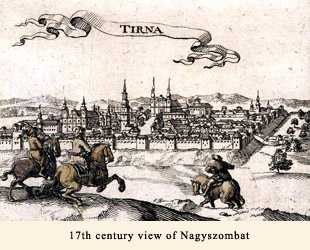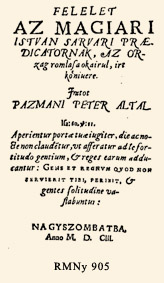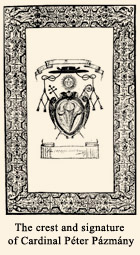 Due to the rapid spread of reformed churches (Lutheran and Calvinist) and the confessional changes in the Hungarian kingdom, it was only in the 1570s that the first Catholic press was founded. It was in 1577 that Miklós Telegdi, Head of the Chapter of Esztergom (seated at the time in Nagyszombat instead of the centrally situated Esztergom occupied by the Turks) established a printing office in his seat: in the north-western part of Hungary. When establishing this printing office, also called after its founder Telegdi Press, he bought the typographical equipment of the Vienna Jesuits, out of use for some years. In this purchase Telegdi was supported both by the Chapter and the Emperor and Hungarian King Rudolf.
Due to the rapid spread of reformed churches (Lutheran and Calvinist) and the confessional changes in the Hungarian kingdom, it was only in the 1570s that the first Catholic press was founded. It was in 1577 that Miklós Telegdi, Head of the Chapter of Esztergom (seated at the time in Nagyszombat instead of the centrally situated Esztergom occupied by the Turks) established a printing office in his seat: in the north-western part of Hungary. When establishing this printing office, also called after its founder Telegdi Press, he bought the typographical equipment of the Vienna Jesuits, out of use for some years. In this purchase Telegdi was supported both by the Chapter and the Emperor and Hungarian King Rudolf.
 The press was especially productive in the lifetime of Telegdi, but András Monoszlói, earlier professor of the Nagyszombat Chapter school of humanist erudition, later provost of Pozsony (Bratislava, SK), was similarly dedicated to the activity of the press. He was also author of several Catholic polemic books against protestants. At the same time the practical leader of the office was Lukács Péchi continuously present in Nagyszombat until the 1600s.
The press was especially productive in the lifetime of Telegdi, but András Monoszlói, earlier professor of the Nagyszombat Chapter school of humanist erudition, later provost of Pozsony (Bratislava, SK), was similarly dedicated to the activity of the press. He was also author of several Catholic polemic books against protestants. At the same time the practical leader of the office was Lukács Péchi continuously present in Nagyszombat until the 1600s.
It was this catholic printing shop where the earliest polemic writings by Peter Pázmány were published between 1603 and 1609 (e.g. RMNy 905 and RMNy 984). In the last year of activity of the press (1609) of the three works by Pázmány only one was printed here, the others in Graz (RMny 980) respectively Pozsony in the newly established Archiepiscopal Press (RMNy 986). 
PIt is well discernible that the once richly equipped printing shop established by Miklós Telegdi in 1577 has lost its significance by the 1600s. Although it continued to issue a reduced number of books, their appearence did not reflect the rich typographical material it possessed. Of the ornaments only one tail-piece, a simple coat of arms of Hungary and some letters of the once complete set of decorative intitials were employed. The majority of the wood-cut calendar illustrations were still existing, but only ten of them can be seen in the calendar for 1604 (RMNy 917). The printing types became worn and new ones were not introduced.
Recent researches produced evidence that there are identical features between the products of the Singriener office in Vienna and those of the Chater (Telegdi) printing shop. The explanation is, that at the time Telegdi bought the printing shop of the Vienna Jesuits, a certain part of the Singriener equipment had already been present in it, like the series of decorated intitials with the planetary figures. That is why the latter series can be discovered in the books printed at Nagyszombat, even in the 1600s. But also other decorative elements from the Vienna Jesuit press are present in the books printed in Nagyszombat at the Chapter (Telegdi) press.
Afterlife of the Chapter (Telegdi press):
The Chapter Press ceased its activity after 1609. The printing types disappeared, were possibly melt, however the way of certain pieces of the equipment can be followed. At present it cannot be explained how, even before the Nagyszombat press dissolved, some of the decorative initials of Vienna origins cropped up in the contemporary, Lutheran-oriented printing shop of Johannes Manlius. Others, as the new Testament series of small woodcuts originally from the Singriener press in Vienna, went over to the possession of another Lutheran printing office, that of Jakob Klöss in Bártfa (Bardejov, SK). Certain wood-blocks of the press went into the newly founded (1609) Archiepiscopal typography after its moving to Nagyszombat (1619). When the Transylvanian Prince Gábor Bethlen occupied with his troops Nagyszombat, he took the press with its equipment first to Kassa (Košice, SK), and from there to his Transylvanian seat Gyulafehérvár (Alba Iulia, RO). Thus the press, serving once the Catholic church, became the Calvinist Principal Press in Transylvania. All its products display the equipment (printing types, ornaments) known from the Archiepiscopal Press, moreover, there are also some illustrations in the books issued in Gyulafehérvár, that must have come from the Chapter press, that had ceased in 1609 – meaning, that certain remains of it, some wood-blocks were still kept in Nagyszombat even ten years after the press was closed. Further, some other wood-blocks of the Chapter press appeared in the books issued by the printing press founded by Cardinal Peter Pázmány in Pozsony in 1623 (handled as a Jesuit College press) – to substitute the former Archiepiscopal press carried to Gyulafehérvár by Gábor Bethlen.
|
Two initials decorating books printed in Nagyszombat in the 1600s: letter N originates from the Vienna press of Singriener, while letter P from the Vienna Jesuits |
It is not known why the Chapter Press of Nagyszombat ceased its activity after 1609. There are no data at our disposal that would explain it, we have only typographical evidence that prove the above outlined scattering of the once rich equipment. However, the Catholic church could not exist without a printing press, and in 1609 the Archiepiscopal press was founded in Pozsony by Ferenc Forgách.

INITIALS, PRINTER’S FLOWERS, PRINTING TYPES
<<back to the top<<

LITERATURE:
Régi magyarországi nyomtatványok (RMNy) – Res litteraria Hungariae vetus operum impressorum, 2: 1601–1635, ed. By Borsa Gedeon and Hervay Ferenc. Budapest 1983.
BÁNFI Szilvia: A bécsi Singriener-nyomda (1510–1562) könyvdíszeinek utóélete a magyarországi nyomtató műhelyekben. = MKsz 2010: 24–55.
V. ECSEDY Judit: A könyvnyomtatás Magyarországon a kézisajtó korában. Bp. 1999. 131–132
V. ECSEDY Judit: A régi magyarországi nyomdák betűi és díszei XVII. század. 1. köt. Nyugat- és észak-magyarországi nyomdák. Káptalani nyomda Nagyszombatban (578–1609). Bp. 2010. 43––4., 245–254.